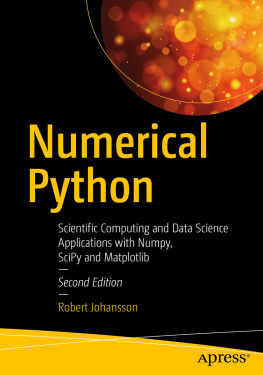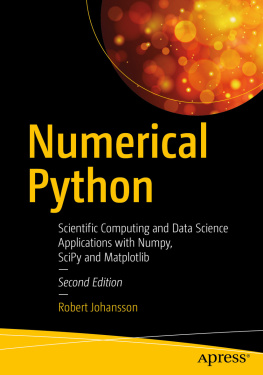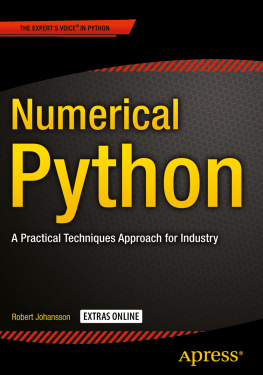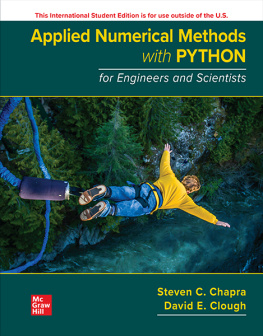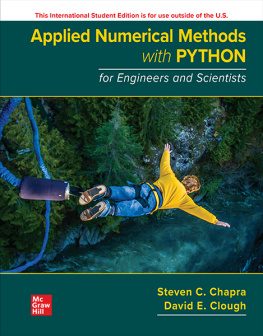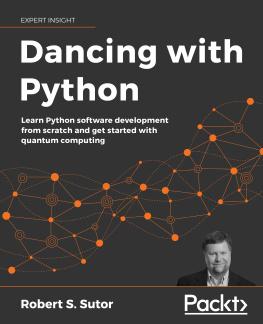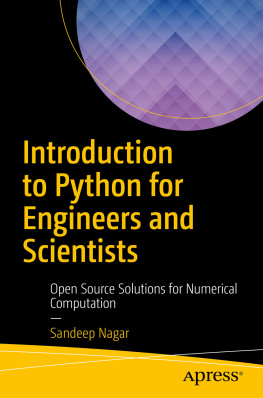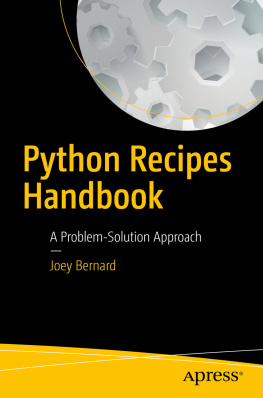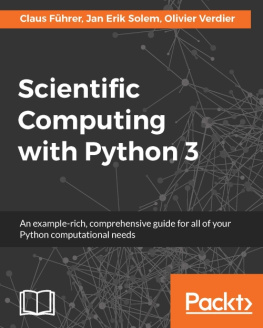Robert Johansson - Numerical Python
Here you can read online Robert Johansson - Numerical Python full text of the book (entire story) in english for free. Download pdf and epub, get meaning, cover and reviews about this ebook. year: 2020, publisher: Apress, genre: Home and family. Description of the work, (preface) as well as reviews are available. Best literature library LitArk.com created for fans of good reading and offers a wide selection of genres:
Romance novel
Science fiction
Adventure
Detective
Science
History
Home and family
Prose
Art
Politics
Computer
Non-fiction
Religion
Business
Children
Humor
Choose a favorite category and find really read worthwhile books. Enjoy immersion in the world of imagination, feel the emotions of the characters or learn something new for yourself, make an fascinating discovery.
- Book:Numerical Python
- Author:
- Publisher:Apress
- Genre:
- Year:2020
- Rating:4 / 5
- Favourites:Add to favourites
- Your mark:
- 80
- 1
- 2
- 3
- 4
- 5
Numerical Python: summary, description and annotation
We offer to read an annotation, description, summary or preface (depends on what the author of the book "Numerical Python" wrote himself). If you haven't found the necessary information about the book — write in the comments, we will try to find it.
Numerical Python — read online for free the complete book (whole text) full work
Below is the text of the book, divided by pages. System saving the place of the last page read, allows you to conveniently read the book "Numerical Python" online for free, without having to search again every time where you left off. Put a bookmark, and you can go to the page where you finished reading at any time.
Font size:
Interval:
Bookmark:
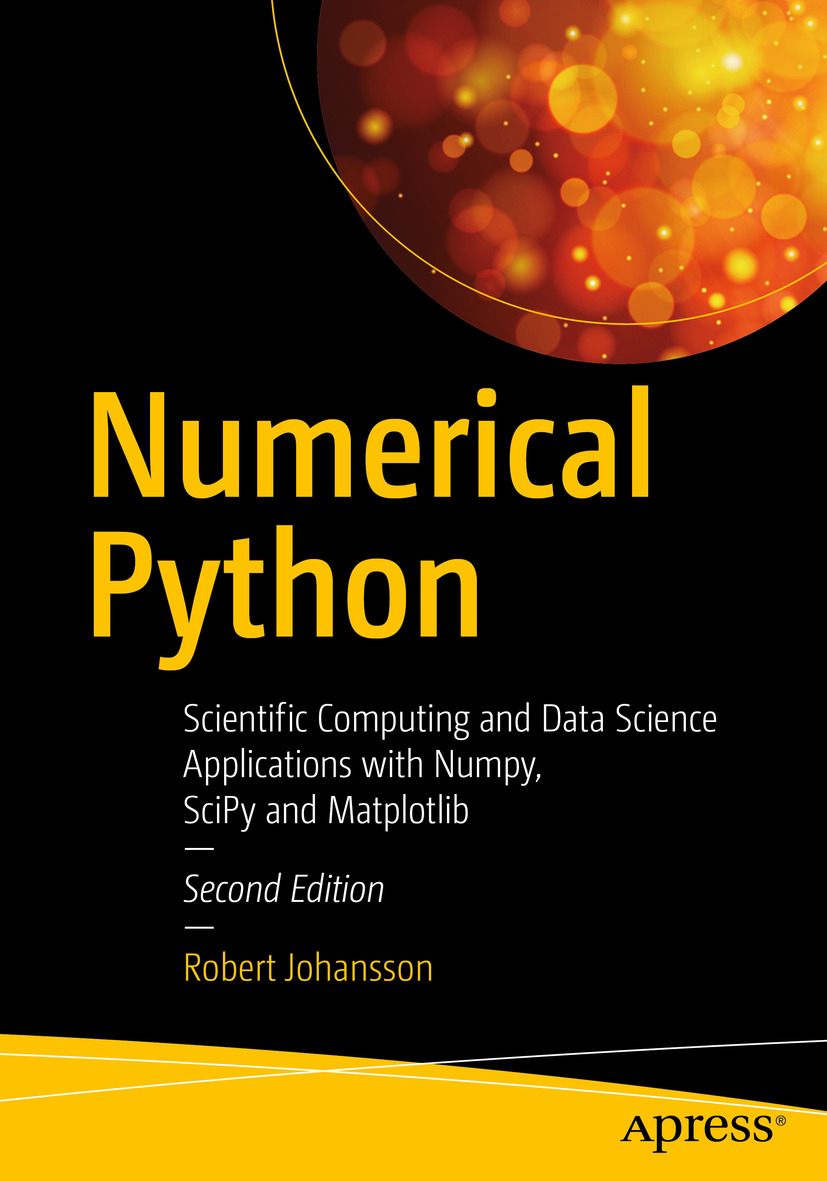

Any source code or other supplementary material referenced by the author in this book is available to readers on GitHub via the books product page, located at www.apress.com/9781484242452 . For more detailed information, please visit http://www.apress.com/source-code .
To Mika and Erika.
Scientific and numerical computing is a booming field in research, engineering, and analytics. The revolution in the computer industry over the last several decades has provided new and powerful tools for computational practitioners. This has enabled computational undertakings of previously unprecedented scale and complexity. Entire fields and industries have sprung up as a result. This development is still ongoing, and it is creating new opportunities as hardware, software, and algorithms keep improving. Ultimately the enabling technology for this movement is the powerful computing hardware that has been developed in recent decades. However, for a computational practitioner, the software environment used for computational work is as important as, if not more important than, the hardware on which the computations are carried out. This book is about one popular and fast-growing environment for numerical computing: the Python programming language and its vibrant ecosystem of libraries and extensions for computational work.
Computing is an interdisciplinary activity that requires experience and expertise in both theoretical and practical subjects: a firm understanding of mathematics and scientific thinking is a fundamental requirement for effective computational work. Equally important is solid training in computer programming and computer science. The role of this book is to bridge these two subjects by introducing how scientific computing can be done using the Python programming language and the computing environment that has appeared around this language. In this book the reader is assumed to have some previous training in mathematics and numerical methods and basic knowledge about Python programming. The focus of the book is to give a practical introduction to computational problem-solving with Python. Brief introductions to the theory of the covered topics are given in each chapter, to introduce notation and remind readers of the basic methods and algorithms. However, this book is not a self-consistent treatment of numerical methods. To assist readers that are not previously familiar with some of the topics of this book, references for further reading are given at the end of each chapter. Likewise, readers without experience in Python programming will probably find it useful to read this book together with a book that focuses on the Python programming language itself.
The first chapter in this book introduces general principles for scientific computing and the main development environments that are available for work with computing in Python: the focus is on IPython and its interactive Python prompt, the excellent Jupyter Notebook application, and the Spyder IDE.
In Chapter provide the basic computational tools that will be used for domain-specific problems throughout the rest of the book: numerics, symbolics, and visualization.
In Chapter cover core computational techniques that are pervasive in all types of computational work. Most of the methods from these chapters are found in the SciPy library.
In Chapter .
Starting with Chapter provide an introduction to the broad field of statistics and data analytics: a field that has been developing rapidly within and outside of the scientific Python community in recent years.
In Chapter , the final regular chapter in this book, two methods for speeding up Python code are introduced, using the Numba and Cython libraries.
The Appendix covers the installation of the software used in this book. To install the required software (mostly Python libraries), we use the conda package manager. Conda can also be used to create virtual and isolated Python environments, which is an important topic for creating stable and reproducible computational environments. The Appendix also discusses how to work with such environments using the conda package manager.
Each chapter in this book has an accompanying Jupyter Notebook that contains the chapters source code listings. These notebooks, and the data files required to run them, can be downloaded by clicking the Download Source Code button located at www.apress.com/9781484242452 .

is an experienced Python programmer and computational scientist, with a Ph.D. in Theoretical Physics from Chalmers University of Technology, Sweden. He has worked with scientific computing in academia and industry for over 10 years, and he has participated in both open source development and proprietary research projects. His open source contributions include work on QuTiP, a popular Python framework for simulating the dynamics of quantum systems; and he has also contributed to several other popular Python libraries in the scientific computing landscape. Robert is passionate about scientific computing and software development and about teaching and communicating best practices for bringing these fields together with optimal outcome: novel, reproducible, and extensible computational results. Roberts background includes 5 years of postdoctoral research in theoretical and computational physics, and he is now working as a data scientist in the IT industry.
Font size:
Interval:
Bookmark:
Similar books «Numerical Python»
Look at similar books to Numerical Python. We have selected literature similar in name and meaning in the hope of providing readers with more options to find new, interesting, not yet read works.
Discussion, reviews of the book Numerical Python and just readers' own opinions. Leave your comments, write what you think about the work, its meaning or the main characters. Specify what exactly you liked and what you didn't like, and why you think so.

